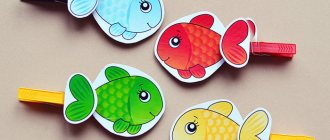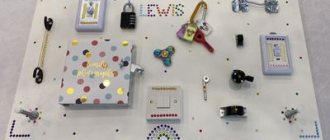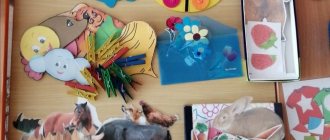Games for the development of fine motor skills, middle group, 5 games for the development of fine motor skills
- Game with a pencil - the children are given pencils. You need to place it between your palms and rotate it so that it moves from the tips of your fingers to the bases of your palms. Ask children to hold the pencil so that the ring and index fingers are on top, and the little and middle fingers are on the bottom.
- Rubber band game - Have your child pull a rubber band between their middle and index fingers. Now you need to imagine that children are playing the guitar, fingering the strings (rubber band) with the middle and index fingers of the second hand.
- Magic bag - you need to take two sets of identical toys. One hides in a bag, the second in front of the teacher. The teacher shows the child a toy, and he must feel the same one in the bag and take it out.
- Game with a ball - first let the children roll the ball on the table, pushing it with their left hand and catching it with their right, and vice versa. Then they twirl the ball, holding it with their thumb and middle finger, then with their thumb and forefinger.
- Playing with counting sticks - let the child lay out patterns and geometric shapes from sticks.
Card index of didactic games for the development of fine motor skills
Margarita Solovyova
Card index of didactic games for the development of fine motor skills
Game "Travel of Fingers"
Purpose of the game: Development and training of coordination of finger movements, development of fingertips, development of attention .
Equipment: a sheet of paper depicting 2 houses at different ends, “islands”
for moving fingers.
Progress of the game: the child places his fingers near the first house. Then he begins to move his fingers along the islands to another house, without taking his fingers off the other “bump.”
.
Rules:
you can move, for starters, using 2 fingers;
all fingers must be involved;
You cannot tear off the first finger without moving the other one.
Game "Scissors"
Purpose of the game: Coordination of movements, training of hand muscles, concentration
attention, development of fine motor skills .
Equipment: a tray on which scissors lie (preferably plastic ones with blunt ends)
and several sheets of thick colored paper. Some sheets have cut lines marked.
How to play: The presenter asks a riddle: Two ends, two rings, and a carnation in the middle. After the child has guessed correctly, the presenter offers to cut the paper with scissors. If the child did it easily, he is given the task of cutting along the lines and performing complex movements to cut out the pattern.
It should be taken into account that, having acquired the skills to confidently hold scissors, the child will then be able to hold a pencil and draw precise lines on paper with the same confidence.
Game "Colorful clothespins"
Purpose of the game: development of fine motor skills of the hands , training in color discrimination, development of attention .
Equipment: 2 sets of baskets with wooden multi-colored clothespins (12 pcs.)
. The basket can be replaced with a cup or plate, or a plastic bucket. The main thing is that the clothespins easily cling to the edges.
Progress of the game: The leader and the child each have a basket with colored clothespins. The leader takes the basket, puts it on the table and asks the child to give him a clothespin and name its color. Then the presenter shows how you can attach a clothespin to the edge of the basket with three fingers. When the child masters this action and can easily attach clothespins, for example, all the clothespins are the same color and name their color, he is given the task of attaching clothespins in a certain sequence of colors, go perform a certain sequence of clothespins as on the leader’s basket. You should pay attention to the fact that the leader attaches the clothespins with three fingers, since the child must see the correct movements.
Repeated repetition of the movement of unclenching and squeezing clothespins trains the fingertips, provides a tonic massage and pressure on the muscle points responsible for activating the speech centers of the brain.
Game "Find the surprise"
Purpose of the game: Development of fine motor skills , coordination of movements; teaching patience.
Equipment: Wrappers (10-15 pieces, small items (badges, buttons, etc., puffed corn, nuts.
Progress of the game: The presenter wraps the badge in 4-5 candy wrappers. The child must unwrap all the candy wrappers and fold them carefully.
Game "Collect all the pebbles"
development of attention.
Equipment: Pebbles, sand, basin.
How to play: Throw pebbles into the sand. First, invite your child to collect pebbles with the first three fingers of his right hand (reinforcing the skill)
.
Purpose of the game: Development of fine motor skills of the hands , development of fingertips,
Development of fine motor skills in children
Exercises after 3 years
Beads and cereals
This category includes games with small objects. It can be anything - beads, beads, various cereals, etc.
You can start with larger items. For example, large beads that a child will play with great interest in his hands.
Another option is cereals. Pour buckwheat or other cereal into a bowl and give it to your baby. He will touch it, roll it in his fingers. In this way, children develop tactile sensations and fine motor skills well.
You can add some kind of goal to these activities. For example, pour buckwheat onto the table and ask your child to separate the black grains from normal buckwheat. You can also ask him to sort the beads by color.
Screwing and unscrewing lids
Developing fine motor skills by screwing or unscrewing bottle caps (it’s better to choose different sizes) is a good exercise for developing dexterity in children’s fingers.
A similar effect is achieved by unfastening and fastening zippers and buttons. In addition, this way the child quickly learns to be independent. You can gradually develop in your child the understanding that he must button his own jacket, lace his shoes, etc.
Modeling
It is suitable for children of different ages. You can use different materials - plastic dough, plasticine, clay. Try to add variety to your classes every time. For example, if at first you just give your child plasticine, and he tries to mold something out of it, then later you can add some objects to the lessons and tell your child to stick plasticine around them. Handprints and various objects can be made from clay.
Parents can be advised to take their child with them to the kitchen when you want to bake something. Let your baby work with the dough, knead it with his hands, but be careful and remove all sharp objects.
Sand games
There are many different variations possible here. The child can draw with his finger in the sand, you can hide some objects and ask the child to find them in the sand. Such activities are only suitable for children over 3 years old, because young children put everything in their mouth.
Drawing, cutting, puzzles, construction sets
Cutting out figures and various objects from paper has an extremely beneficial effect on the development of fine motor skills. Here you need to start with something simple (cutting out shapes with straight lines) and move on to something more complex (cutting out shapes with curved lines, snowflakes, etc.). Carving is also useful because it develops spatial perception.
The same goes for drawing. At first, you can simply give your child a felt-tip pen and full scope for creativity. Then ask him to complete the missing part of the drawing, draw a line along the contours, etc.
Construction sets and puzzles not only develop fine motor skills, but also have a beneficial effect on a child’s imagination, memory and creativity. In addition, the baby develops patience and perseverance. There are a large number of options on sale for children of different ages.
Games for the development of fine motor skills senior group, 5 games for the development of fine motor skills
- Color it correctly - give the children images of geometric shapes and show them how to shade them (straight, tilted to the right and left).
- Paper crafts - teach children to make simple shapes, a cap or a boat out of paper.
- Shadow theater – create a theater in a shadowed room with a light source. Teach children to make shapes from their fingers and assign them roles.
- Cinderella - mix two types of cereals, give the children two containers and ask them to sort through the cereals, separating them.
- The letter grows - a large letter is drawn in one part of the sheet, and a small letter in the other. Ask your child to show how the letter grows by writing the same letter a little larger next to the small one and gradually increasing it until it grows into a large one.
Games for the development of fine motor skills, junior group, 5 games for the development of fine motor skills
- Watchmaker - in front of the child is a tray with cells, a cup with beads and tweezers. The baby must carefully grab the bead with tweezers and transfer it to the cell.
- Beads for the doll - you will need thread and buttons or special wooden beads. Children must string it on a string.
- Colored droplets - prepare an ice tray. Circle the first cells with a red felt-tip pen, the second with blue, and the third with yellow. Place three jars of water of the same colors in front of your child. The baby’s task is to use a pipette to transfer water from the container to the ice tray according to the colors.
- Matryoshka - the teacher rattles a large matryoshka, takes out a medium one from it, and a small one from the middle one. Talks about sizes and compares them. Then he invites the children to collect nesting dolls.
- Search in cereals - objects or toys are hidden in a bowl of cereal that the child needs to find. Pay attention to the child that the cereal should not spill onto the table.
Games for the development of fine motor skills preparatory group, 5 games for the development of fine motor skills
- Roll up the ribbon - there are two ribbons on a stick, attached to it at one end. They need to be rolled up quickly.
- Make it out of matches - give the children figures and ask them to make them out of sticks or matches inside.
- Patterns from threads - according to the sample cards, the children must lay out certain knots and patterns, loops from threads. When children learn, you can play without models.
- Remember - the teacher lays out a pattern from counting sticks, the child looks at it for several seconds. Then you need to repeat this pattern from memory using sticks.
- On skis - place plastic bottle caps on the table and hit them with your middle and index fingers. Simulate skiing on a table, avoiding obstacles.
When playing games, pay attention to the frequent use of small objects. Be careful that small children do not swallow them or place them where they are not supposed to. Allow children to play only under the supervision of an adult.
Card games for developing fine motor skills
- I’ll draw a berry - the children outline the contours of the berries drawn on a sheet of paper with small beads.
- Needles - the child should roll a hair brush (round) in his palms, imagining that these are needles from a Christmas tree.
- Guess the letter - two teams of guys. Each one sculpts a letter given by the teacher. Then the children take turns and, with their eyes closed, must determine by touch what letter their opponents have made.
- Snow made of napkins - children are given a napkin each. You need to tear it into small pieces with your fingers to make snow, without helping with your other hand. The one who finishes it the fastest wins.
- Feed the piglet - add legs and a muzzle to the plastic bottle that lies on the table. Ask the children to feed the piglet, putting beans and peas in the neck.





